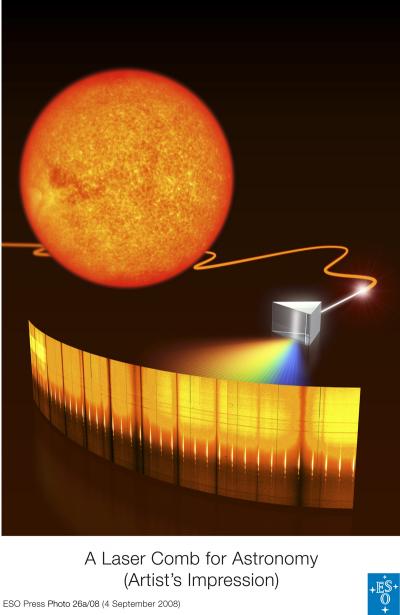" Laser Comb" To Measure the Accelarating Universe
 Back in April, UT published an article about using a device called a 'laser comb' to search for Earth-like planets. But astronomers also hope to use the device to search for dark energy in an ambitious project that would measure the velocities of distant galaxies and quasars over a 20-year period. This would let astronomers test Einstein's theory of general relativity and the nature of the mysterious dark energy. The device uses femto-second (one millionth of one billionth of a second) pulses of laser light coupled with an atomic clock to provide a precise standard for measuring wavelengths of light. Also known as an “astro-comb,” these devices should give astronomers the ability to use the Doppler shift method with incredible precision to measure spectral lines of starlight up to 60 times greater than any current high-tech method. Astronomers have been testing the device, and hope to use one in conjunction with the new Extremely Large Telescope which is being designed by ESO, the European Southern Observatory.
Back in April, UT published an article about using a device called a 'laser comb' to search for Earth-like planets. But astronomers also hope to use the device to search for dark energy in an ambitious project that would measure the velocities of distant galaxies and quasars over a 20-year period. This would let astronomers test Einstein's theory of general relativity and the nature of the mysterious dark energy. The device uses femto-second (one millionth of one billionth of a second) pulses of laser light coupled with an atomic clock to provide a precise standard for measuring wavelengths of light. Also known as an “astro-comb,” these devices should give astronomers the ability to use the Doppler shift method with incredible precision to measure spectral lines of starlight up to 60 times greater than any current high-tech method. Astronomers have been testing the device, and hope to use one in conjunction with the new Extremely Large Telescope which is being designed by ESO, the European Southern Observatory.
Astronomers use instruments called spectrographs to spread the light from celestial objects into its component colors, or frequencies, in the same way water droplets create a rainbow from sunlight. They can then measure the velocities of stars, galaxies and quasars, search for planets around other stars, or study the expansion of the Universe. A spectrograph must be accurately calibrated so that the frequencies of light can be correctly measured. This is similar to how we need accurate rulers to measure lengths correctly. In the present case, a laser provides a sort of ruler, for measuring colors rather than distances, with an extremely accurate and fine grid.
New, extremely precise spectrographs will be needed in experiments planned for the future Extremely Large Telescope.
"We'll need something beyond what current technology can offer, and that's where the laser frequency comb comes in. It is worth recalling that the kind of precision required, 1 cm/s, corresponds, on the focal plane of a typical high-resolution spectrograph, to a shift of a few tenths of a nanometre, that is, the size of some molecules," explains PhD student and team member Constanza Araujo-Hauck from ESO.
The new calibration technique comes from the combination of astronomy and quantum optics, in a collaboration between researchers at ESO and the Max Planck Institute for Quantum Optics. It uses ultra-short pulses of laser light to create a 'frequency comb' - light at many frequencies separated by a constant interval - to create just the kind of precise 'ruler' needed to calibrate a spectrograph.
The device has been tested on a solar telescope, a new version of the system is now being built for the HARPS planet-finder instrument on ESO's 3.6-metre telescope at La Silla in Chile, before being considered for future generations of instruments.
More information on laser combs.
Sumber: ESO
Popular Posts
-
Abstrak Pada era yang kita katakan modern saat ini, perkembangan astronomi di dunia sudah semakin maju. Sementara itu, perkembangan...
-
LAPORAN HASIL PENGAMATAN HILAL RAMADHAN 1434 H HIMPUNAN ASTRONOMI AMATIR JAKARTA PANTAI ANYER, BANTEN – 08 JULI 2013 Hasil foto m...
-
Pertemuan Rutin Dwimingguan Himpunan Astronomi Amatir Jakarta (HAAJ) edisi ke-tigabelas di tahun 2013 International Space Statio...
-
1. Kaos Astronomi Kaos-kaos Bertemakan Astronomi ada di sini.. untuk pemesenan bisa melalui 085714655720 . Bahan Kaos Combed 20s ...
-
Pertemuan Rutin Dwimingguan Himpunan Astronomi Amatir Jakarta (HAAJ) edisi ke-limabelas di tahun 2013 Universe Al-Qur’an mer...
-
Pertemuan Rutin Dwimingguan Himpunan Astronomi Amatir Jakarta (HAAJ) edisi ke-empatbelas di tahun 2013 Hilal. Kredit : HAAJ ...
-
Sesi Foto terakhir sebelum kembali kerumah masing-masing. Kredit : Reza Cerita Perjalanan dari Atala - 8 Tahun Ingatan Atala di Pu...
-
Ilmu Astronomi sudah sejak lama dikenal di Indonesia dan masih berkembang hingga sekarang. Namun di tengah perkembangannya, ilmu ini ...
-
Report Pertemuan Rutin Himpunan Astronomi Amatir Jakarta (HAAJ) Planetarium Jakarta, 01 Juni 2013 Suasana Pada Saat Pertemuan ...
-
Back in April, UT published an article about using a device called a 'laser comb' to search for Earth-like planets. But astronomers...




.jpg)

.jpg)


1 Response to "" Laser Comb" To Measure the Accelarating Universe"
what is viagra viagra benefits viagra free pills generic soft tab viagra viagra from india does watermelon have viagra effect viagra cialis levitra viagra discount how long does viagra last generic viagra online buying viagra online in britain viagra or cealis bad side effects of viagra viagra lawyer ohio
Post a Comment